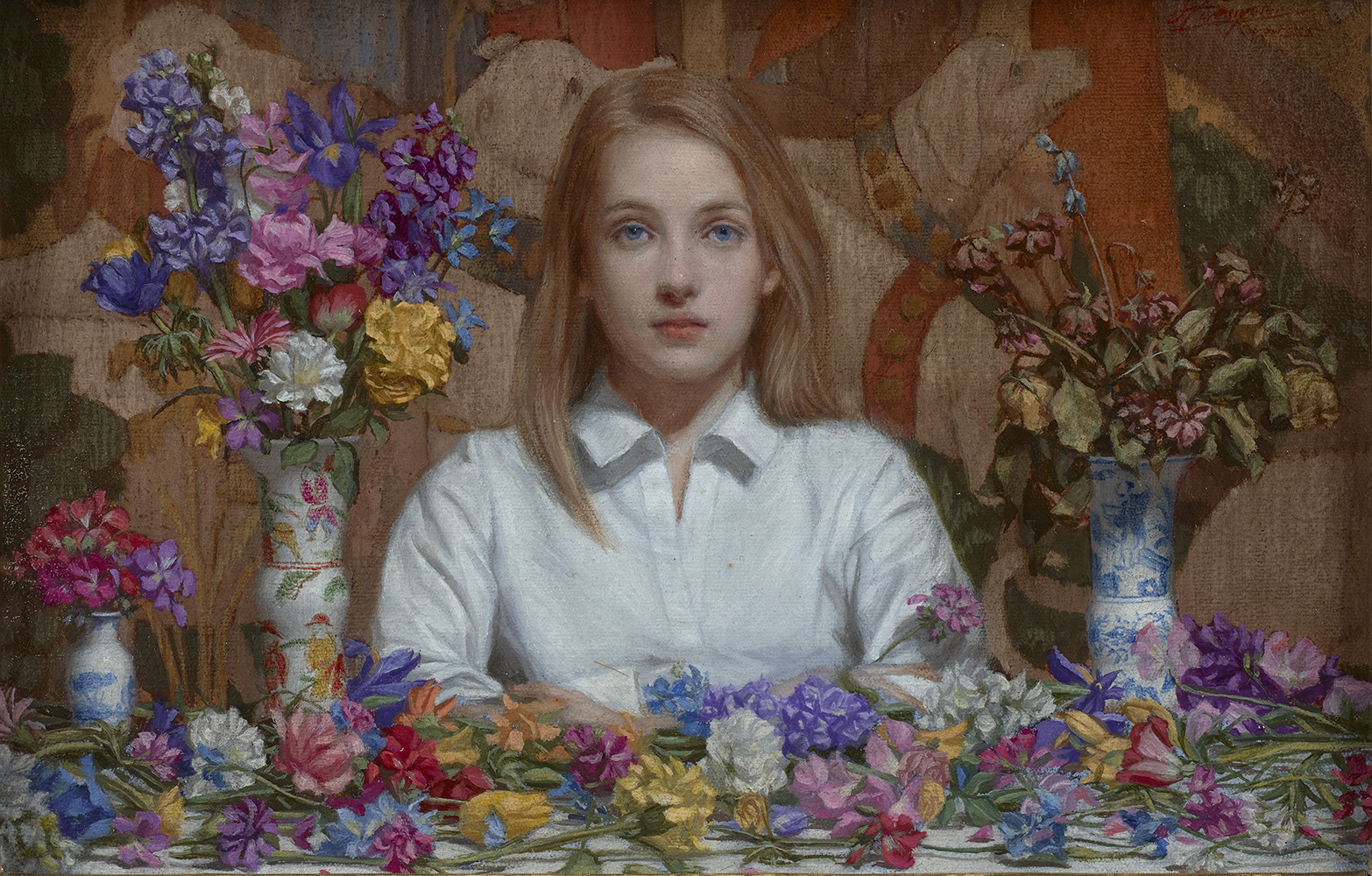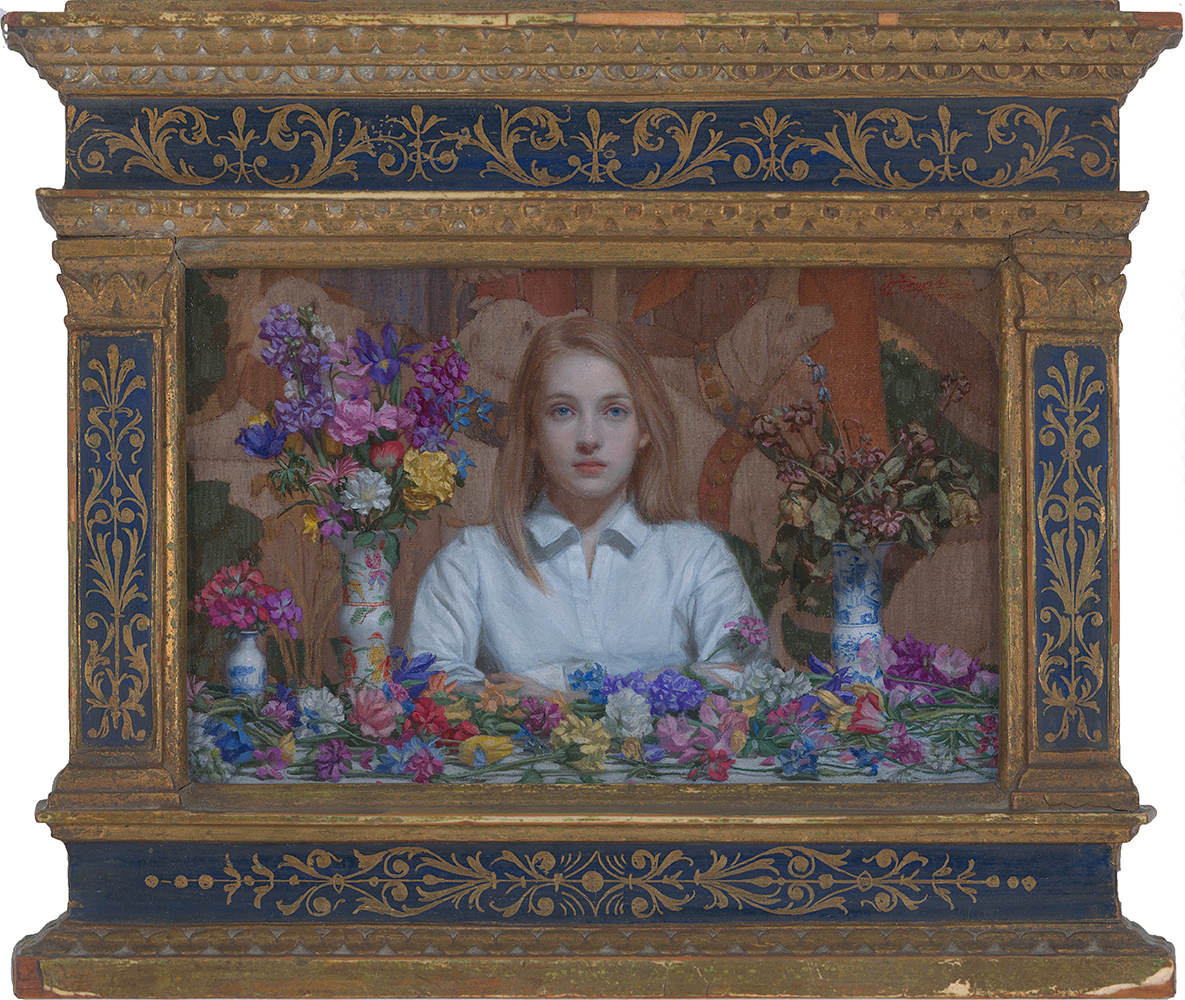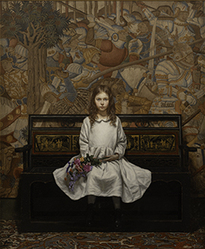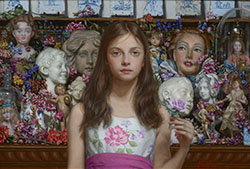Hiroshi Furuyoshi
(Born 1959)
Ella
Oil on panel
3 1/2 x 5 1/2 inches
Signed
BIOGRAPHY - Hiroshi Furuyoshi (Born 1959)
Born in Hiroshima in 1959, Hiroshi’s childhood was spent surrounded by the antiques and art in his family’s shop. His grandfather, who loved collecting antiques, decided to pursue his interest by developing a business tailored to the middle-class antiques market. By the time that Hiroshi’s father became the proprietor, the store was filled with a wide range of Japanese paintings, calligraphy, tea utensils, books and trinkets. In other words, it offered a visual feast to a fledgling artist.
Hiroshi recalls discovering the world of manga when he was about five years old. By the time he was ten, he was reading comics about Japanese history and beginning to take an interest in Japanese art as well. The wealth of art books available to him through the shop and at home meant that he could explore the history of art in depth whenever he liked. His parents were happy to encourage his interest, taking him to the museum and providing him with new art books as well. His mother, in particular, shares his fascination with visual art, perhaps because she was exposed to aesthetic questions at an early age as the daughter of a kimono dyer.
One of the childhood experiences that most impressed Hiroshi was seeing an oil reproduction of Sir Thomas Lawrence’s portrait of Master Charles William Lambton, known today as The Red Boy (1825), hanging above the stamp counter at a local department store. Although he was only eleven years old, the future painter thought that “it would be very cool to be able to paint such a realistic painting”. It would take him a few more years before he attempted oil painting, but the exposure to that image seems to have been a formative moment in his development as an artist.
At school, Hiroshi enjoyed his art classes, but notes that he was not fond of studying and so did not do especially well in general. In spite of this, he was an enthusiastic reader, continuing his habit of absorbing books on art and history as often as possible. In the early 1970s, he made a thorough study of a book on European painting before accompanying his father on a trip to Rome and Paris. For eight days, he experienced the museums and galleries of those cities, as well as the plentiful sculpture in the urban landscapes. His focus at that time was on the painting of the seventeenth and eighteenth centuries, but he now comments that if he’d had a book on nineteenth century European painting then, he probably would have enjoyed that even more.
Back home in Hiroshima, his teacher recommended that he consider attending Kyoto Art Junior College after finishing high school. The art college was relatively new at the time and Hiroshi’s parents encouraged him to try it out. He was sorely disappointed to discover that the classical art that he loved was not part of the curriculum; and that his art teachers were not interested in teaching realistic approaches to painting and drawing. He soon found himself back in the library copying from art books and teaching himself how to draw.
Hiroshi’s luck changed with the opening of a private art school in Kyoto where traditional western painting techniques were taught. There he studied with Toshiro Aoki, who had spent many years living and working in Europe, with a particular focus on the styles of seventeen century Holland. On his return to Japan, Toshiro helped to define a new Realist movement in painting. As Hiroshi comments, “I learned a lot from him.”
After graduation, the artist returned home to Hiroshima where he worked in the family store and continued to paint copies of Old Master works that he saw in art books. It wasn’t until 1985 that he decided to venture into the marketplace when he submitted his painting to a competition organized by an art gallery in Tokyo. Within a year, he had his first solo exhibition of his miniature canvases. Five years later, he moved to Tokyo where he attracted the attention of several galleries who were eager to exhibit his work on an annual basis. Hiroshi’s primary focus was then--and remains today--on miniature images based on western art tropes.
His success in the Tokyo galleries also meant that Hiroshi could expand his knowledge of the western art market. He began to subscribe the auction catalogues in 1985, but he was completely surprised when he saw his own painting on the back cover of an auction catalogue in June 2010. A painting entitled Julien was featured as an advertisement for an auction that month in London. The work depicts a young boy dressed in late eighteenth-century clothes standing in front of a very large shelving unit with fifty-six perfect cubes containing a plethora of seemingly random objects. It is very much in the western tradition of a cabinet of curiosity with its ceramics and books and fabrics and dolls and skulls and candlesticks and silver vases--all of them piled chaotically into the cubes. Perhaps most unexpected of all was that the canvas sold for £40,000 ($59,000), almost six times the high estimate.
Following the unanticipated success of Julien, Hiroshi revised his approach to marketing and began to focus less on solo exhibitions and more on public sales in an international market. In 2012, his painting titled Maya was estimated to bring £3-5,000 and sold for over £52,000 ($82,000); then in 2016 Adelaide hit the market with a £7-10,000 estimate and brought a record £80,500 ($106,000). As a result, he has been able to move to Kyoto where he notes that “there are many historical cultural assets and delicious food.”
Janet Whitmore, Ph.D.
| AVAILABLE WORKS | |||




